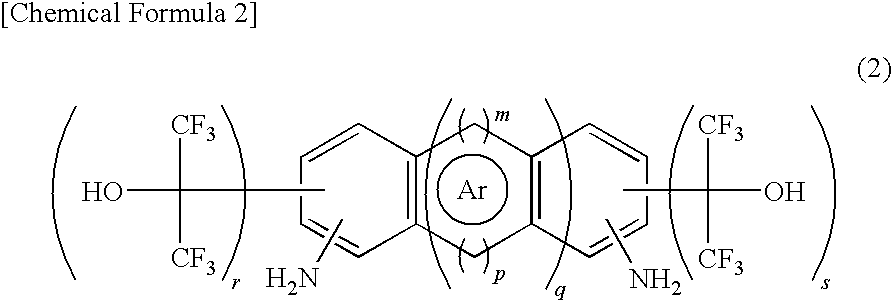Fluorinated Diamine and Polymer Formed Therefrom
a technology of fluorinated diamine and polymer, which is applied in the field of new, fluorinecontaining, rigid diamine and novel polymer compounds, can solve the problems of inferior thermal characteristics, achieve superior low temperature curing properties, improve heat resistance characteristics, and increase rigidity of this inner skeleton
- Summary
- Abstract
- Description
- Claims
- Application Information
AI Technical Summary
Benefits of technology
Problems solved by technology
Method used
Image
Examples
example 1
Production of 2,6-bis(1-hydroxy-1-trifluoromethyl-2,2,2-trifluoroethyl)-1,5-naphthalene diamine
[0091]A 100 ml sealed container (autoclave) made of glass was charged with 4.05 g (25.6 mmol) of 1,5-naphthalene diamine, 0.49 g (2.6 mmol) of p-toluenesulfonic acid monohydrate, and 45.6 g (207.4 mmol, 8,1 equivalents) of hexafluoroacetone trihydrate, and the inside of the system was turned into under nitrogen atmosphere. Then, the temperature increase was started. After the reaction was conducted at an inside temperature of 120° C. for 46 hours, the reaction liquid was cooled down.
[0092]The reaction liquid was found by gas chromatography (GC) analysis to be 93% of the target compound, 2,6-bis(1-hydroxy-1-trifluoromethyl-2,2,2-trifluoroethyl)-1,5-naphthalene diamine and 7% of 2-(1-hydroxy-1-trifluoromethyl-2,2,2-trifluoroethyl)-1,5-naphthalene diamine. After adding 25 mL of water to the reaction liquid, stirring was conducted. After filtering this mixed liquid, the recovered solid was dis...
example 2
[0094]Production of 2,7-bis(1-hydroxy-1-trifluoromethyl-2,2,2-trifluoroethyl)-1,6-anthracene diamine 5.53 g (yield 40%, purity 99%) of 2,7-bis(1-hydroxy-1-trifluoromethyl-2,2,2-trifluoroethyl)-1,6-anthracene diamine, the target compound, was obtained by a method similar to that of Example 1 from 5.33 g (25.6 mmol) of 1,6-anthracene diamine, 0.49 g (2.6 mmol) of p-toluenesulfonic acid monohydrate, and 45.6 g (207.4 mmol, 8.1 equivalents) of hexafluoroacetone trihydrate.
example 3
Synthesis of model compound [2,6-bis(1-hydroxy-1-trifluoromethyl-2,2,2-trifluoroethyl)-1,5-bis(benzoylamino)naphthalene]
[0095]A 200 ml, three-necked, round-bottom flask was charged with 2.00 g (4.1 mmol) of 2,6-bis(1-hydroxy-1-trifluoromethyl-2,2,2-trifluoroethyl)-1,5-naphthalene diamine, 1.29 g (16.3 mmol, 4 equivalents) of pyridine, and 30 mL of tetrahydrofuran, and the inside of the system was turned into nitrogen atmosphere. Under room temperature, 1.06 g (8.6 mmol, 2.1 equivalents) of benzoyl chloride was added in dropwise manner. Stirring was conducted at room temperature for 2 hours, and stirring was conducted at 60 degrees for 24 hours. After the reaction, the reaction liquid was introduced into water, and the obtained solid was separated by filtration. The recovered solid was dissolved in methanol, and this was subjected to crystallization in water, and the obtained crystals were dried under reduced pressure. 0.80 g (yield 29%, purity 99%) of 2,6-bis(1-hydroxy-1-trifluorome...
PUM
| Property | Measurement | Unit |
|---|---|---|
| temperature | aaaaa | aaaaa |
| boiling point | aaaaa | aaaaa |
| boiling point | aaaaa | aaaaa |
Abstract
Description
Claims
Application Information
 Login to View More
Login to View More - R&D
- Intellectual Property
- Life Sciences
- Materials
- Tech Scout
- Unparalleled Data Quality
- Higher Quality Content
- 60% Fewer Hallucinations
Browse by: Latest US Patents, China's latest patents, Technical Efficacy Thesaurus, Application Domain, Technology Topic, Popular Technical Reports.
© 2025 PatSnap. All rights reserved.Legal|Privacy policy|Modern Slavery Act Transparency Statement|Sitemap|About US| Contact US: help@patsnap.com



